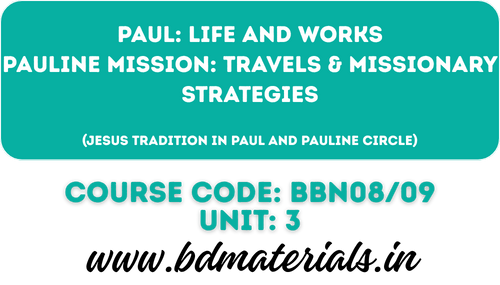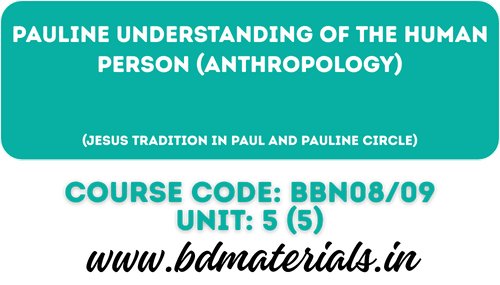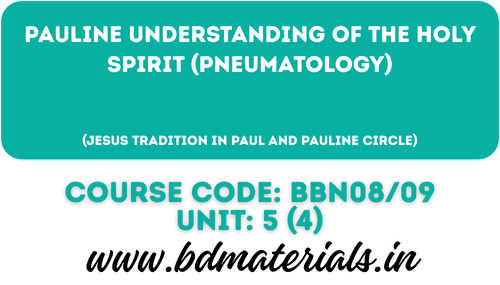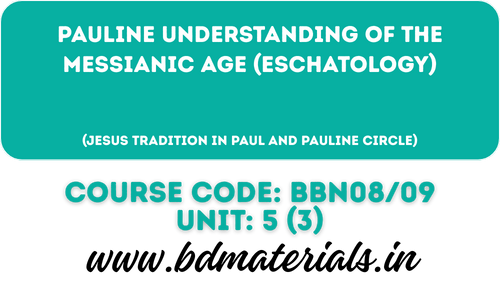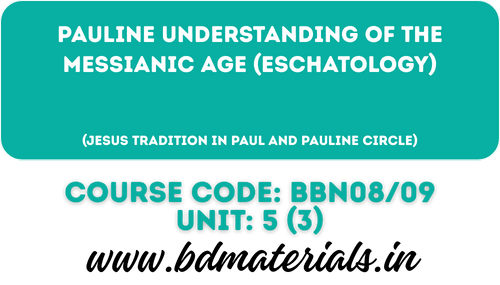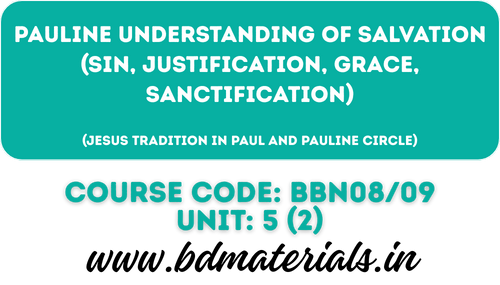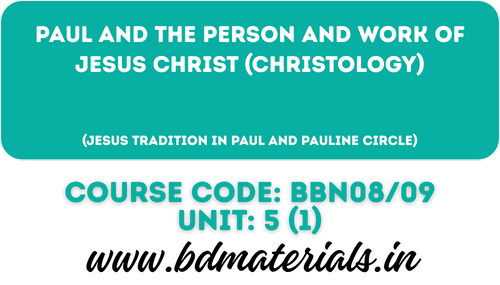Pauline Mission: Travels & Missionary Strategies
Introduction:
Among all the New Testament writers Paul is highly regarded as a Christian theologian. Paul the missionary cannot be separated from Paul the theologian, for missionary work and theological reflection about the gospel are mutually dependent. This paper attempts to bring out how Paul was doing his mission and what strategies he had in his ministry.
1. The Missionary Period:
After Jesus, Paul is known as the greatest cross-cultural missionary in the New Testament. In the book of Acts, his missionary journeys are conventionally described as three distinct journeys. The first missionary journey focuses on Paul ministry in Cyprus and Galatia (Acts 13-14). The second missionary journey takes Paul via Asia minor to Europe, where he preached in the provinces of Macedonia and Achaia (Acts 15:36-18:22). The third missionary journey covers Paul’s ministry in Ephesus, which concludes with a journey to Macedonia to Achaia (Acts 18:23-21:16).1
1.1. Paul’s First Missionary Journey:
The account of Paul’s first missionary journey is mentioned in Acts 13-14. Major regions that Paul covered in this Journey is Syria, Cyprus, Lycia, the region of Pamphylia, Galatia the region of Pisidia, Lycaonia, Iconium of Galatia and Lycia. Paul covered these areas probably in AD 48-49.2
Paul and Barnabas were commissioned by the church in Antioch to board an evangelistic mission. As of Acts 13:2, it was upon the initiation of the Holy Spirit that Paul and Barnabas were set apart for the work to which God has called them. Being set apart by the Holy Spirit, the elders of the church laid their hands on them and sent them off. Barnabas took John Mark as a companion in this mission. It took them across the island of Cyprus and through South Galatia.3
The central Pauline mission strategy seen in all of his journeys was to preach first in the Jewish Synagogues followed by interaction with them. As a result of this strategy, God fearing Jews accepted the message of the cross became followers of Christ, and thus became the pillar of the local assembly. On the other hand, Paul did not face opposition and hatred from the Orthodox Jews in his mission trips. When the gospel is rejected by the mass Jews, sometimes with violence, he shifted the focus towards the Gentiles (Acts13:46). Despite all the perils and the hardship that he faced such as the defection of John Mark (Acts 13:13), the mission of Paul along with Barnabas succeeded in establishing Christian witnesses in Pisidian Antioch, Iconium, Lystra, Derbe, and Perga.4
1.2. Second Missionary Journey:
The second missionary travel can be categorized into five phases according to the area they covered, such as, Syria – Cilicia, Asia Minor, Macedonia, Achaia, and Back to Syria. Paul covered three areas probably in AD 50-52/53. The length of the journey was approximately 3 years and covered around 2700 miles of which 1290 by sea and 1410 by land. Luke mentions Paul’s second missionary journey in Acts 15:36 – 18:22.5
1.3. Third Missionary Journey:
Paul’s third missionary journey traversed much the same ground as his second. He started his Journey in AD 53 which lasted till AD 57 (four years). In this journey, Paul traveled around 2515 miles that covered 1190 miles by sea and 1325 miles by land. Passing through Galatia and Phrygia, he proceeded directly to the great port city of Ephesus. After three years of preaching and teaching there (Acts 20:31), Paul traveled again through Macedonia and Achaia, strengthening the believers, and then finished with a visit to Jerusalem. Luke’s mention of Paul’s third missionars third missionary journey is found in Acts 18:23-21:26.6
2. Paul’s mission strategy:
The following description on the goals of Paul’s Missionary work can be regarded as a description of Paul’s missionary strategy.
2.1. Preaching the Gospel:
Paul’s description of his missionary task focuses on the preaching of the gospel as the primary goal. This premier goal of his missionary calling is formulated in classic manner in Paul’s self- description in his letter to the Christian in Rome: “Paul, a servant of Jesus Christ, called to be an apostle, set a part for the gospel of God” (Rom 1:1). Paul understood his primary task as an apostle who has been called and sent by God to preach the gospel.7
The word gospel meaning “good tidings” is euangelion in Greek, generally good “news” or “tidings”. The verb euangelizomai used 19 times by Paul in the Greek Old Testament (Septuagint) as the translation for the Hebrew term bisser, which in English means “to announce, tell, deliver a message.” In the book of Isaiah, “the herald of good news” announces the new era of God’s kingly rule, which inaugurated by the messenger’s announcement. Another term that Paul uses to describe his preaching ministry is the Greek verb katangello, which is often translated as “to proclaim” and which can be defined as “to make known in public, with implication of broad dissemination.” The message proclaimed is “the mystery of God” (1Cor 2:1), “the gospel” (1 Cor 9:14), “the death of the Lord” (1 Cor 11:26), “Christ” (Phil 1:17,18), “him” (Col 1:28), that is, “Christ in you, the hope of glory” (Col 1:27).8
The task of the herald in the Greco-Roman world helps us to understand Paul’s proclamation of good news. Paul describes himself as a “herald in 1 Timothy 2:7 and 2 Timothy 1:11, and he often employs the verb herald to describe the basic process of the oral proclamation of the gospel of Jesus Christ. The term herald describes a man who calls out in a clear and audible manner a message that he has been told by a ruler or the magistrates of a city-state to convey a message to the constituency. This announcement is usually “news” in the sense that its content has not been known before.9
2.2. Conversion of Individuals:
The goal of Paul’s missionary work is the conversion of Jews and pagans to faith in Jesus Messiah, Savior and Lord, the transformation of traditional patterns of religious, ethical and social behavior, and the integration into the community of fellow believers. In Luke’s description of Paul’s conversion and missionary calling, he articulates the apostle’s conviction that he has been called by Jesus the Messiah to help the Gentiles “turn from darkness to light and from the power of Saran to God” (Acts 26:18). In narratives the Greek term epistrepho denotes, as does the Hebrew term sub, physical movements, turnings, changes of place. It means “to return to a point where one has been, to turn around, to go back” or “to change direction to turn around.”10
Used figuratively (as here), it means “to cause a person to change belief or course of conduct, with focus on the thing to which one turns” or “to change one’s mind or course of action.” Another term Paul uses to describe conversion is the Greek term metanoia (verb metanoeo). The significant semantic connotation of the term is the concept of change (of mind), both in a good and a bad sense. The verb can mean “to perceive afterwards or too late” (to be sorry for), “to change one’s mind” or “to change one’s opinion.” The Septuagint uses the term to translate Hebrew niham “to be sorry (for something).” The Hebrew term sub is again decisive for the use of this term in the New Testament: “repentance” is a turning away from sin (Mk 1:4-5).11
2.3. Establishing Communities of Followers of Jesus:
Paul’s missionary work did not end with the oral proclamation of the good news of Jesus Christ and the conversion of individuals. Paul established churches, communities of men and women who had come to faith in Jesus the Messiah and Savior, and who came together to study the Scriptures, to be instructed in the whole counsel of God, to learn and remember what Jesus Christ had done, to discover the will of God for their lives, and to celebrate God’s salvation in Jesus Christ in prayers and in hymns and spiritual songs.12
When Jews and Gentiles were converted to faith in Jesus Christ, responding to Paul’s preaching in the local synagogue or in the market place, Paul insisted that they continue to meet together for instruction and worship. The venue for these meetings was initially the local synagogue. As the followers of Jesus were regularly evicted by the leaders of the synagogues, they might meet in public lecture halls or, usually, in private houses. When Paul writes letters to the Christians in the cities where he had engaged in missionary work, he does not write to individuals. He writes to the congregation as a whole. In 1 Thessalonians, one of the earliest letters Paul wrote, he addresses the letter to “the church of the Thessalonians in God the Father and the Lord Jesus Christ” (1 Thes 1:1). The closing of the letter, where he requests that the letter be read to all the brothers and sisters, and that they greet each other with a holy kiss (1 Thes 65:26-27), shows that “Paul has in mind an actual gathering of theThessalonian Christians.” Paul describes the church as belonging to God, through whose power Jews and pagans found faith in Jesus, the crucified and risen Messiah and Savior.13
2.4. Teaching New Converts:
The challenges of establishing and consolidating new churches were enormous. The integration of Jewish believers and Gentiles Christians was not easy. Jewish believers needed to learn new ways of behavior, abandoning legal traditions that had regulated their dealings with pagans and made fellowship (e.g., during meals) with pagans difficult or impossible. Even more challenging was the integration of converted pagans into the new messianic people of God. They needed to learn new values and new patterns of behavior in many different areas, not the least in terms of their sexual activities. Paul describes himself as a teacher “in every church” (1 Cor 4:17). His rulings on theological and ethical questions are relevant for “all the churches” (1 Cor 7:17; cf 11:16; 14:33; 16:1). Paul’s letters reveal the following focal points.14
- a) Theological instruction.
- b) Ethical instruction.
- c) Instruction concerning the life of the church.
- d) Evangelistic outreach.15
2.5. Training New Missionaries:
A further goal of Paul’s missionary work was the training of new missionaries. The coworkers who accompanied Paul on his travels participated in his missionary activities and can thus be seen as trainees, much like Jesus’ disciples who had been chosen by Jesus to with him (Mk 3:13-15) and to be trained as “fishers of people” (Mk 1:17).16
Paul uses nine different designations for the coworkers who are listed: brother, apostle or envoy, servant, slave (fellow-slave), companion or partner, worker, soldier (fellow-soldier), fellow prisoner, and fellow-worker. Further expressions that are used for some of Paul’s coworkers include prophet, teacher, traveling companion, shepherd, proclaimer of the gospel, servant or minister, manager or administrator, helper or assistant.17
Conclusion:
Paul’s vision had two dimensions: global and local. It was this vision which motivated him to follow some strategies in his mission. It is important for those who are engaged in mission to select the area, place, whether urban or rural, and the target group among whom they are called to work, but they should operate with a universal vision. Both universality and particularity should go hand in hand in Christian mission. Paul was careful enough to train, equip and install local leaders in each congregation and thus facilitated indigenous leadership in churches so that they may communicate the gospel more relevantly in their own language and in their native cultural set-up. Identifying potential leaders within local congregations and training them is vital to Christian mission.
Bibliography:
- Bruce, F. F. Commentary on the Book of Acts. Grand Rapids: Eerdmans, 1960.
- Grassi, J.A. A World to Win: The Missionary Methods of Paul the Apostle. New York: Maryknoll Publications, 1965.
- Jose, Jojan. Life and Thoughts of Paul. Delhi: Christian World Imprints, 2021.
- Moore, Beth. Paul 90 Days of his Journey of Faith. Nashville: B&H Publishing Group, 2010.
- Schnabel, Eckhard J. Paul the Missionary: Realities, Strategies and Method. Westmont: Intervarsity Press, 2008.
Footnotes
- Jojan Jose, Life and Thoughts of Paul (Delhi: Christian World Imprints, 2021), 111.
- Beth Moore, Paul 90 Days of his Journey of Faith (Nashville: B&H Publishing Group, 2010), 87.
- Moore, Paul 90 Days of his Journey of Faith, 87.
- Moore, Paul 90 Days of his Journey of Faith, 87.
- F. F. Bruce, Commentary on the Book of Acts (Grand Rapids: Eerdmans, 1960), 275.
- Bruce, Commentary on the Book of Acts, 275.
- Eckhard J. Schnabel, Paul the Missionary: Realities, Strategies and Method (Westmont: Intervarsity Press, 2008), 210.
- Schnabel, Paul the Missionary: Realities, Strategies and Method, 211.
- Schnabel, Paul the Missionary: Realities, Strategies and Method, 211.
- J.A. Grassi, A World to Win: The Missionary Methods of Paul the Apostle (New York: Maryknoll Publications, 1965), 74.
- Grassi, A World to Win: The Missionary Methods of Paul the Apostle, 74.
- Grassi, A World to Win: The Missionary Methods of Paul the Apostle, 74.
- Grassi, A World to Win: The Missionary Methods of Paul the Apostle, 75.
- Schnabel, Paul the Missionary: Realities, Strategies and Method, 236.
- Schnabel, Paul the Missionary: Realities, Strategies and Method, 236.
- Schnabel, Paul the Missionary: Realities, Strategies and Method, 248.
- Schnabel, Paul the Missionary: Realities, Strategies and Method, 248.
Friendly Note
Greetings in the name of our Lord Jesus Christ! We are deeply thankful for your visit to BD Materials. It is our mission and joy to serve Bible students, pastors, and believers with high-quality theological resources that strengthen faith and understanding of God’s Word.
At BD Materials, you’ll find study notes, articles, question papers, and valuable academic content designed to support your biblical and theological education. We are dedicated to helping you grow in knowledge, ministry, and devotion to Christ.
We also invite you to explore our partner sites: Telugu Gospel Lyrics, featuring inspiring gospel song lyrics in Telugu, and Theological Library, a hub for Christian book summaries and devotionals.
Your encouragement means a lot to us! We invite you to share your study materials, articles, or insights with our community. Thank you for being part of this mission—may God bless your studies and ministry abundantly!

